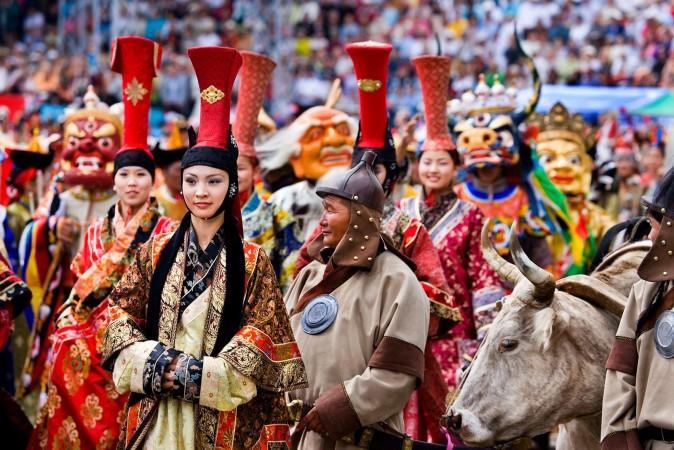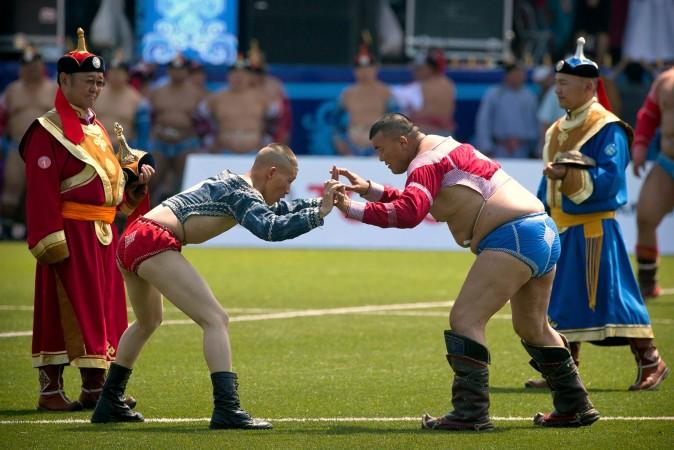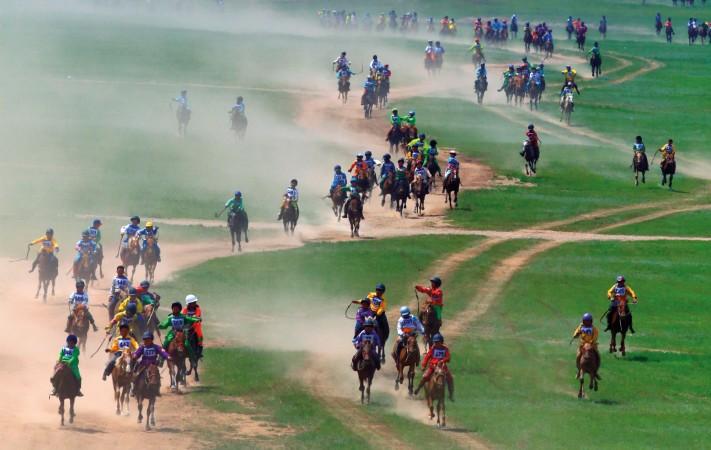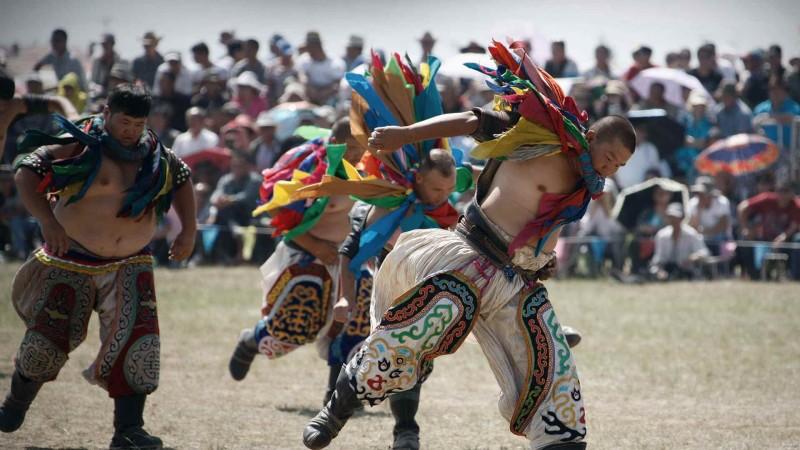Explorez le spectacle du Festival Naadam en Mongolie
Chaque mois de juillet, la Mongolie prend vie avec le vibrant et excitant Festival Naadam, une célébration séculaire de l'histoire culturelle riche et de l'esprit indomptable du pays. Connu localement sous le nom de "Eriin Gurvan Naadam", ce qui se traduit par "Les Trois Jeux Virils", ce festival met en valeur les meilleurs athlètes du pays dans la lutte, les courses de chevaux et le tir à l'arc.
Naadam n'est pas seulement un événement sportif ; c'est une profonde expression de l'identité de la Mongolie, reflétant des traditions qui remontent à l'époque de Gengis Khan. Que vous soyez un passionné d'histoire, un explorateur culturel ou un chercheur d'aventure, Naadam offre une fenêtre unique sur le cœur et l'âme de la Mongolie. Prêt à plonger dans l'aventure avec Tweet Tours ?
Mongolia

Histoire et Signification du Festival Naadam
Origines Anciennes
Les racines du Festival Naadam sont profondément ancrées dans le passé historique de la Mongolie. Historiquement, les origines du festival remontent à l'Empire Hunnu, et il a été officialisé sous le règne de Gengis Khan (1162-1227). Au début du XIIIe siècle, après avoir unifié les tribus mongoles, Gengis Khan organisa des jeux pour maintenir ses guerriers prêts au combat en temps de paix. Ces jeux n'étaient pas seulement récréatifs ; ils constituaient un terrain d'entraînement rigoureux qui aiguisait la puissance physique et mentale des soldats.
Évolution Moderne
En 1921, Naadam fut déclaré jour férié national pour commémorer l'indépendance de la Mongolie vis-à-vis de la domination chinoise. L'ère soviétique a vu des tentatives de suppression des coutumes traditionnelles, mais Naadam a survécu, devenant un symbole de fierté nationale et d'unité. En 2010, l'UNESCO a reconnu Naadam comme un patrimoine culturel immatériel de l'humanité, consolidant son statut de composante essentielle de l'identité culturelle de la Mongolie. Aujourd'hui, Naadam est célébré avec ferveur à travers le pays, de la capitale animée d'Oulan-Bator à la campagne tranquille et pittoresque.
Reconnaissance de l'UNESCO
L'inclusion de Naadam dans la liste de l'UNESCO souligne son importance culturelle. Selon l'inscription de l'UNESCO en 2010, "Le Naadam mongol est indissociablement lié à la civilisation nomade des Mongols", soulignant son rôle crucial dans la conservation des compétences traditionnelles et la création d'une cohésion communautaire. Les rituels et coutumes observés pendant Naadam, des vêtements traditionnels aux danses cérémoniales, sont des symboles précieux de l'héritage durable de la Mongolie.

Festival Naadam - © rassembler
Principaux Événements et Compétitions du Festival Naadam
Lutte Traditionnelle Mongole (Bökh)
La lutte traditionnelle mongole, ou Bökh, est le point central de Naadam et un spectacle qui suscite un immense intérêt local et international. Contrairement à d'autres formes de lutte, le Bökh n'a ni catégories de poids ni limites de temps. L'objectif est simple mais difficile : faire toucher le sol à votre adversaire avec autre chose que ses pieds. Les matchs se déroulent en élimination directe, culminant par une grande finale où le vainqueur est couronné champion.
L'uniforme de lutte, composé d'un Zodog (veste sans col) ajusté et d'un Shuudag (short), est conçu pour permettre une mobilité maximale. Les titres attribués aux vainqueurs, tels que "Arslan" (Lion) et "Avarga" (Titan), portent une grande estime. Les lutteurs célèbres deviennent souvent des héros locaux, célébrés pour leur force, leur habileté et leur esprit sportif. Selon la légende locale, Gengis Khan lui-même considérait la lutte comme un moyen essentiel de maintenir ses soldats en forme et prêts pour le combat.

Scènes du festival annuel Naadam de Mongolie - © Mark Schiefelbein/AP
Courses de Chevaux Traditionnelles Mongoles
Les courses de chevaux de Naadam sont uniques en leur genre, caractérisées par de longues distances et de jeunes jockeys. Les chevaux concourent dans des catégories selon leur âge, avec des distances allant de 15 à 30 kilomètres. Les jockeys, généralement des enfants âgés de 6 à 12 ans, incarnent le courage et l'habileté nécessaires pour naviguer à grande vitesse à travers les vastes steppes de la Mongolie.
La tradition des jockeys enfants, bien que controversée selon les standards modernes, est profondément enracinée dans la culture mongole. Les courses mettent à l'épreuve l'endurance du cheval et du cavalier, la sueur du cheval gagnant étant considérée comme un symbole de bonne fortune. Les spectateurs se précipitent souvent pour recueillir cette sueur sur leurs vêtements, croyant qu'elle apporte chance et prospérité.

Course de chevaux traditionnelle mongole - © rassembler
Tir à l'Arc Traditionnel Mongol
Le tir à l'arc, dernier sport parmi les « Trois Jeux Virils » de Naadam, met en valeur la précision et la concentration des archers mongols. Il existe trois types principaux de tir à l'arc pratiqués selon les recherches de la Fondation Asie-Europe : Khalkha, Buryad et Uriankhai, chacun avec des règles et un équipement distincts.
Pendant Naadam, les compétiteurs visent des cibles en cuir placées à différentes distances, les hommes tirant généralement à 75 mètres et les femmes à 60 mètres. Les archers portent des vêtements traditionnels mongols et suivent des rituels transmis de génération en génération. La compétition ne consiste pas seulement à toucher la cible ; il s'agit de maintenir sa maîtrise de soi et sa technique sous pression. L'habileté des archers mongols est légendaire, les archives historiques rapportant des exploits tels que toucher des cibles à plus de 500 mètres de distance.

Concours de tir à l'arc pendant le Festival Naadam - © Shutterstock
Activités Culturelles et Sociales du Festival Naadam
Cérémonie d'Ouverture
Le Festival Naadam commence par une grande cérémonie d'ouverture qui est tout simplement spectaculaire. Organisée au Stade National des Sports d'Oulan-Bator, la cérémonie offre une vibrante démonstration de la culture traditionnelle mongole, incluant musique, danse et costumes élaborés. Les festivités débutent par un défilé d'athlètes, chacun représentant les trois sports virils : la lutte, les courses de chevaux et le tir à l'arc.
Les danseurs exécutent la danse traditionnelle biyelgee, tandis que les chanteurs emplissent l'air de chants de gorge touvains mélodieux, appelés khöömei. Le point culminant de la cérémonie est le transfert symbolique des Neuf Drapeaux Blancs, représentant l'unité et la force des tribus mongoles à l'époque de Gengis Khan. Cet événement donne le ton pour l'ensemble du festival, célébrant l'héritage culturel riche de la Mongolie et la fierté nationale.

Le Festival Naadam - © rassembler
Vêtements Traditionnels Mongols
Pendant Naadam, les Mongols portent leurs plus beaux vêtements traditionnels, appelés deel. Cette longue robe fluide, généralement faite de soie ou de coton, est ornée de motifs élaborés et de couleurs vives. Il n'est pas rare de voir des familles et des amis porter des deels assortis, témoignant de leur héritage commun et de l'esprit communautaire. La jeune génération ajoute souvent une touche moderne en associant le deel à des accessoires contemporains comme des lunettes de soleil et des baskets. Porter un deel n'est pas seulement une question de mode ; c'est une manière de se connecter à l'histoire et à la culture mongoles.
Plats Traditionnels Mongols
Naadam est un festin pour les sens, surtout en ce qui concerne la nourriture. La pièce maîtresse culinaire du festival est le khuushuur, une pâtisserie frite remplie de viande assaisonnée, généralement de mouton. La pâte croustillante et dorée est meilleure lorsqu'elle est servie chaude et se marie parfaitement avec des légumes marinés. Une autre délicatesse traditionnelle est l'airag, un lait de jument fermenté au goût légèrement acide et à faible teneur en alcool. C'est une boisson agréable lors d'une chaude journée d'été pendant le festival. Pour ceux qui souhaitent se régaler davantage, des stands de nourriture proposent une variété de viandes grillées, de boulettes et de pâtisseries sucrées.

Khuushuur - © Javkhlantugs Ragchaasuren (Javkha Ara)
Comment Assister au Festival Naadam
Conseils de Voyage
- Assister au Festival Naadam nécessite un peu de planification, mais l'effort en vaut vraiment la peine.
- Les principales festivités ont lieu à Oulan-Bator, mais des événements Naadam plus petits sont organisés à travers toute la Mongolie.
- Pour les voyageurs internationaux, l'option la plus pratique est de voler vers l'Aéroport International Chinggis Khaan à Oulan-Bator. De l'aéroport, le centre-ville est facilement accessible en taxi ou en bus.
- Pour vivre l'ensemble du festival, prévoyez de séjourner en Mongolie pendant au moins une semaine, afin de pouvoir explorer à la fois la capitale et la campagne.
- Pour une expérience plus immersive, pensez à réserver l'un des forfaits touristiques de Tweet Tours Mongolia, qui incluent souvent le transport, l'hébergement et les billets pour le festival.
Billets et Entrée
Obtenir des billets pour le Festival Naadam, surtout pour la cérémonie d'ouverture à Oulan-Bator, peut être difficile en raison de la forte demande. Les billets sont généralement mis en vente quelques semaines avant le festival et s'épuisent rapidement. Il est conseillé d'acheter des billets dans le cadre de votre forfait touristique. Contactez le centre d'appels de Tweet Tours ou discutez avec nous dans la boîte de chat pour plus de détails.
- Les prix varient de 25 $ pour le premier jour à 10-12 $ pour les jours suivants.
Si les billets pour l'événement principal sont épuisés, ne vous inquiétez pas. De nombreux festivals Naadam locaux, organisés dans de petites villes et villages, offrent une entrée gratuite et offrent une expérience culturelle tout aussi riche. Ces festivals plus petits sont moins bondés et permettent une interaction plus proche avec les habitants.

Festival Naadam au stade national - © Marcin Konsek
Conseils de Bagages
Lorsque vous préparez vos bagages pour le Festival Naadam, prenez en compte le climat variable de la Mongolie.
Les étés peuvent être chauds pendant la journée, mais frais le soir. Il est recommandé de porter des vêtements légers et respirants, ainsi qu'une veste ou un pull chaud pour la nuit. Des chaussures de marche confortables sont essentielles, car vous passerez beaucoup de temps à explorer les terrains du festival. N'oubliez pas la protection solaire, incluant un chapeau, des lunettes de soleil et de la crème solaire, ainsi qu'une gourde réutilisable pour rester hydraté. Un petit sac à dos peut être utile pour transporter les essentiels, et n'oubliez pas d'apporter un appareil photo ou un smartphone pour capturer les moments inoubliables.
Étiquette Culturelle
Les Mongols sont connus pour leur hospitalité, et respecter les coutumes locales enrichira votre expérience. Lors de votre participation à Naadam, il est important de s'habiller de manière modeste et de se comporter respectueusement. Si vous êtes invité à partager un repas ou une boisson avec des habitants, acceptez toujours avec la main droite et offrez une petite inclinaison de gratitude. Pendant les événements, notamment dans les villages plus petits, interagir avec les habitants et apprendre leurs traditions peut vous offrir des perspectives plus profondes sur la signification du festival. En tant que visiteur, votre intérêt et votre respect pour leur culture seront grandement appréciés, rendant votre expérience de Naadam encore plus mémorable.

Festival Naadam en Mongolie - © rassembler
Influence sur la Communauté Ethnique et l'Économie de la Mongolie
Le Festival Naadam renforce considérablement l'unité de la communauté ethnique et stimule l'économie de la Mongolie. Célébré à l'échelle nationale, il réunit des personnes de diverses origines ethniques, favorisant un fort sentiment de fierté nationale. D'un point de vue économique, Naadam attire des milliers de touristes, générant des revenus substantiels pour les entreprises locales telles que les hôtels, les restaurants et les opérateurs touristiques. Le festival met en valeur l'artisanat local, les aliments traditionnels et les performances culturelles, contribuant de manière significative à l'économie nationale.
Défis Culturels et Efforts de Préservation du Festival Naadam
Malgré sa popularité, le Festival Naadam fait face à des défis liés à la modernisation et à la commercialisation. L'augmentation du tourisme et des intérêts commerciaux risque de faire ombrage aux pratiques traditionnelles. Pour lutter contre cela, le gouvernement mongol et les organisations culturelles promeuvent les vêtements traditionnels, les rituels et les compétitions.
La reconnaissance de Naadam par l'UNESCO en tant que patrimoine culturel immatériel de l'humanité soutient ces efforts de préservation. Les communautés locales privilégient l'authenticité, notamment dans les petits villages. "Préserver Naadam est essentiel pour maintenir notre identité culturelle," déclare The Diplomat News. "Ces efforts garantissent que Naadam soit une célébration de l'histoire culturelle riche de la Mongolie."

Les lutteurs exécutent la danse de l'aigle avant une compétition de lutte lors du Festival Naadam dans la Ligue de Xilin Gol - © VCG Photo
Conclusion
Le Festival Naadam est bien plus qu'une simple célébration ; c'est une vitrine vivante du tissu culturel unique de la Mongolie et de son esprit résilient. Des compétitions sportives exaltantes aux cérémonies d'ouverture colorées et aux festivités traditionnelles, Naadam offre un aperçu inégalé du cœur de la culture mongole. Que vous soyez passionné d'histoire, amateur d'aventure ou passionné de culture, Naadam promet un voyage inoubliable rempli d'excitation, de communauté et de connexions profondes. Naadam n'est pas seulement un festival ; c'est une célébration du passé, du présent et de l'avenir de la Mongolie, un témoignage vivant de la résilience et de la vitalité de son peuple. Alors, faites vos valises, fixez votre cap sur la Mongolie, et préparez-vous à faire partie de cette tradition intemporelle.
Des articles pour vous

Explore Fukushima - Japan Travel, Asia
Nestled in Japan's scenic Tohoku region, Fukushima offers travelers a unique blend of historical charm, cultural richness, and natural beauty. Known for its stunning landscapes and welcoming communities, Fukushima is an excellent destination for those seeking an authentic Japanese experience beyond the bustling metropolises. Renowned for its diverse attractions, from ancient castles and hot springs to vibrant festivals and picturesque countryside, Fukushima offers a great opportunity for cultural and historical exploration for anyone who loves Japanese culture.
Population: Approximately 1.8 million in 2023.
Economy: Specializing in the seafood and fishing industries, Fukushima, with its historical impacts, now continues to thrive as one of the most developed and largest economies in Japan.
Landmarks: Famous for Aizu-Wakamatsu Castle, Fukushima City Historical Museum, and Ouchi-juku.

La symphonie saisonnière de l'Inde : Révéler les meilleurs moments pour explorer le sous-continent
Les traditions anciennes dansent avec les merveilles modernes dans une terre où les épices et l'encens embaument l'air, et chaque recoin cache une histoire prête à être découverte. L'Inde, vaste et diverse, se déploie comme un monde miniature en soi. Mais quand devriez-vous entreprendre ce voyage épique ? Rejoignez-nous pour un tourbillon à travers la tapisserie saisonnière de l'Inde et trouvez le moment parfait pour votre aventure.

Voyage culinaire à travers la Chine : Savourez les saveurs diversifiées
Des rives subtropicales de Canton aux steppes balayées par le vent du Xinjiang, le vaste paysage de la Chine est une tapisserie de saveurs, chaque région mettant en avant ses propres trésors culinaires. Avec plus de 2000 miles séparant les palais de dim sum du sud des étals de kebabs du nord-ouest, et des woks crépitants entre les deux, la diversité gastronomique de la Chine est véritablement inégalée. Alors, prenez vos baguettes et embarquez pour une aventure gourmande à travers les plats les plus délicieux du Royaume du Milieu !

Vivez l'expérience à bord du RV Indochine II - Une croisière sur le Mékong
Le RV Indochine II est un navire de croisière fluviale de luxe, offrant un voyage inoubliable à travers de nombreuses attractions le long du fleuve Mékong. Construit en 2017, ce vaisseau haut de gamme allie élégance coloniale et commodités modernes pour créer un environnement à la fois confortable et élégant pour son équipage et ses passagers. La taille intime du navire en fait le choix idéal pour ceux qui recherchent une expérience de croisière plus personnelle tout en explorant la culture, les paysages et le patrimoine riches du Vietnam et du Cambodge. Que vous admiriez le paysage depuis votre balcon privé ou que vous dégustiez une cuisine locale authentique, le RV Indochine II promet une aventure exotique hors du commun.

Assistez à la pêche sur pilotis au Sri Lanka
Le Sri Lanka, réputé pour ses plages magnifiques et son riche patrimoine culturel, abrite une tradition unique qui captive les voyageurs depuis des siècles : la pêche sur pilotis. Cette pratique ancienne, transmise de génération en génération au sein des communautés côtières, allie art et nécessité, offrant un aperçu d'un mode de vie intimement lié aux rythmes côtiers de l'île. La pêche sur pilotis au Sri Lanka n'est pas simplement un moyen de capturer des poissons ; c'est un emblème culturel, incarnant la résilience et l'ingéniosité des communautés de pêcheurs sri-lankaises.

À l'assaut des sommets : guide du randonneur de l'Himalaya
Lorsque les premiers rayons du soleil teintent les sommets enneigés de doré et de rose, vous êtes au seuil de l'aventure. Bienvenue dans l'Himalaya, où chaque pas est une immersion dans le plus grand spectacle de la nature. Avec Tweet World Travel comme guide, préparez-vous à un trek d’aventures, qui éveillera vos sens et vous transformera à jamais.
